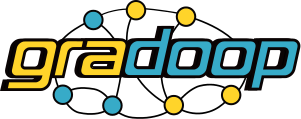-
Notifications
You must be signed in to change notification settings - Fork 89
Getting started
- Java 8
- Apache Flink
To get started with gradoop, we will walk through the setup, and use some basic operators on an example graph. You can find the whole sourcecode of the quickstart here.
The easiest way to use gradoop in your project is via maven. Add one of the following dependencies to your project file:
Stable:
<dependency>
<groupId>org.gradoop</groupId>
<artifactId>gradoop-flink</artifactId>
<version>0.5.2</version>
</dependency>Latest nightly build (additional repository is required):
<repositories>
<repository>
<id>oss.sonatype.org-snapshot</id>
<url>https://oss.sonatype.org/content/repositories/snapshots</url>
<releases><enabled>false</enabled></releases>
<snapshots><enabled>true</enabled></snapshots>
</repository>
</repositories><dependency>
<groupId>org.gradoop</groupId>
<artifactId>gradoop-flink</artifactId>
<version>0.6.0-SNAPSHOT</version>
</dependency>In any case you also need Apache Flink (version 1.7.2):
<dependency>
<groupId>org.apache.flink</groupId>
<artifactId>flink-java</artifactId>
<version>1.7.2</version>
</dependency>
<dependency>
<groupId>org.apache.flink</groupId>
<artifactId>flink-clients_2.11</artifactId>
<version>1.7.2</version>
</dependency>Now you are able to run your gradoop application.
In the following examples we will work with a rather simple graph, so each operation and its results can easily be understood and visualized. Consider the following graph collections that consists of two logical graphs, describing two groups of friends.
As you can see, there are two types of vertices in our graph collection: Person and Company. There are also two types of edges: friendsWith, denoting that a given Person is friends with another, and worksAt, a relation between a Person and a Company. In the Extended Property Graph Model (EPGM), these types are called labels.

Each Person has two characteristics a name and and an age, while our companies only have a name as a property. These key-value pairs are the properties of a graph element. Note that there is no schema involved that forces a certain type of graph element to have specific values. E.g. there could be a third company vertex which also holds information about the size of the company or a person with no key-value pair age.
Both groups of friends make up a separate graph, those are called logical graph in EPGM. Graph elements can belong to more than one logical graph. The vertices Marc and Jacob belong to both groups and since in each group there is at least one person working at each company, they also belong to both logical graphs.
A set of logical graphs is called a graph collection. That's everything we need to know about EPGM for now, if you want to gain a deeper understanding, have a look at the paper.
To create the example data we use the GDL format, which is easy to understand and allows to build small graph collections from strings. Basically a vertex is given by a pair of parentheses ()and edges are represented with arrow-like symbols -[]->. All graph elements can be referred to by a variable name, given a label and key-value pairs. Let's have a look at the source code:
String graph = "g1:graph[" +
"(p1:Person {name: \"Bob\", age: 24})-[:friendsWith]->" +
"(p2:Person{name: \"Alice\", age: 30})-[:friendsWith]->(p1)" +
"(p2)-[:friendsWith]->(p3:Person {name: \"Jacob\", age: 27})-[:friendsWith]->(p2) " +
"(p3)-[:friendsWith]->(p4:Person{name: \"Marc\", age: 40})-[:friendsWith]->(p3) " +
"(p4)-[:friendsWith]->(p5:Person{name: \"Sara\", age: 33})-[:friendsWith]->(p4) " +
"(c1:Company {name: \"Acme Corp\"}) " +
"(c2:Company {name: \"Globex Inc.\"}) " +
"(p2)-[:worksAt]->(c1) " +
"(p4)-[:worksAt]->(c1) " +
"(p5)-[:worksAt]->(c1) " +
"(p1)-[:worksAt]->(c2) " +
"(p3)-[:worksAt]->(c2) " + "] " +
"g2:graph[" +
"(p4)-[:friendsWith]->(p6:Person {name: \"Paul\", age: 37})-[:friendsWith]->(p4) " +
"(p6)-[:friendsWith]->(p7:Person {name: \"Mike\", age: 23})-[:friendsWith]->(p6) " +
"(p8:Person {name: \"Jil\", age: 32})-[:friendsWith]->(p7)-[:friendsWith]->(p8) " +
"(p6)-[:worksAt]->(c2) " +
"(p7)-[:worksAt]->(c2) " +
"(p8)-[:worksAt]->(c1) " + "]";
FlinkAsciiGraphLoader loader = new FlinkAsciiGraphLoader(cfg);
loader.initDatabaseFromString(graph);Note that the edges of Type friend in our example are undirected, to model this property we have to use two mirrored directed edges. You can find detailed information about GDL on github. GDL is not an input format for large scale graphs (as it generates a graph/collection single threaded) and real world data won't be available in this format. However, it is useful to build and evaluate examples like this on the fly and to familiarize with the gradoop operators. For the import of real and/or large data sets, the CSV and JSON data sources are more suitable. You can also check out the DataSources wiki page.
With the overlap operator we can find all elements that are contained in both our logical graphs:
ExecutionEnvironment env = ExecutionEnvironment.getExecutionEnvironment();
GradoopFlinkConfig cfg = GradoopFlinkConfig.createConfig(env);
LogicalGraph n1 = loader.getLogicalGraphByVariable("g1");
LogicalGraph n2 = loader.getLogicalGraphByVariable("g2");
LogicalGraph overlap = n2.overlap(n1);
DataSink sink2 = new DOTDataSink("out/overlap.dot", true);
overlap.writeTo(sink2);
// Note that in flink you always need to call the execute method on the environment
env.execute();To review and validate the results we use the DOTDataSink to write the result graphs in the dot format which can be compiled into an image with Graphviz.

The overlap graphs contains all elements that are present in both logical graphs. The fact that even Marcs work relation with Acme Corp. is not part of the overlap may come as a surprise since both vertices are present. However, notice the respective edge was only defined in g1. The remaining set operators combination, exclusion and equality are straightforward to understand from here. You can try them out and observe the results with the method given above.
Let's try a slightly more complicated example. How can we transform our current input graphs to achieve two graphs that show the members of each company? At first we need to combine the existing graphs to a single graph and use the subgraph operator to filter out all non work-related edges:
LogicalGraph workGraph = n1.combine(n2)
.subgraph(
v -> true,
e -> e.getLabel().equals("worksAt"));Now we want to find all parts of our graph that form a connected component. To achieve this we can use the WeaklyConnectedComponents algorithm from the Flink Gelly library which is available in gradoop.
WeaklyConnectedComponentsAsCollection weaklyConnectedComponents = new WeaklyConnectedComponentsAsCollection(10);
GraphCollection components = weaklyConnectedComponents.execute(workGraph);
DataSink sink3 = new DOTDataSink("out/workspace.dot", true);
components.writeTo(sink3);Using the datasink again, we can validate our results.

Congratulations, you solved your first graph processing problem with gradoop.
- Review the examples
- Learn about advanced methods e.g. Cypher Queries, ...
- How to import data from different sources
